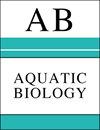Effects of nitrogen source, concentration, and irradiance on growth rates of two diatoms endemic to northern San Francisco Bay
IF 0.8
4区 生物学
Q3 MARINE & FRESHWATER BIOLOGY
引用次数: 4
Abstract
Impacts on growth rates from exposure to ammonium (NH4) and nitrate (NO3), at non-limiting concentrations, in combination with irradiances varying from 25 to 600 μmol photons m−2 s−1 were investigated in the pelagic diatom Thalassiosira weisflogii and the benthic diatom Entomoneis paludosa recently isolated from Suisun Bay in northern San Francisco Bay. Growth rates were higher in T. weisflogii (0.76 ± 0.3 d−1) compared with E. paludosa (0.58 ± 0.2 d−1) across all irradiances and nitrogen (N) treatments. Differences in growth rates with N source were regulated by irradiance in both diatoms and were greatest at the intermediate irradiance due to saturation of rates at 85 μmol photons m−2 s−1 when growing on NH4 and at 200 μmol photons m−2 s−1 when growing on NO3. Notable physiological differences between these 2 diatoms included a larger range in the quantum yield of photosystem II (Fv/Fm) and in chlorophyll a per cell as a function of irradiance in T. weissflogii compared with E. paludosa. In addition, a negative inter action of high NH4 concentration (1000 μmol l−1) and irradiance (≥200 μmol photons m−2 s−1) was observed on growth rates in E. paludosa that was not evident in T. weissflogii. Differences in physiological parameters of these diatoms are discussed in relation to their distributions and frequency of occurrence in Suisun Bay.氮源、浓度和辐照度对旧金山湾北部两种硅藻生长速率的影响
研究了在25 ~ 600 μmol光子m−2 s−1辐照条件下,铵态氮(NH4)和硝态氮(NO3)对最近从旧金山湾北部的suissun Bay分离的浮游硅藻thalassisira weisflogii和底栖硅藻Entomoneis paludosa生长速率的影响。在不同的光照和氮处理下,魏氏柽柳的生长速率(0.76±0.3 d - 1)高于白桫椤(0.58±0.2 d - 1)。两种硅藻的生长速率差异受辐照度的影响,在中等辐照度下最大,因为在NH4和NO3上生长的速率分别达到85 μmol光子m−2 s−1和200 μmol光子m−2 s−1。两种硅藻之间的显著生理差异包括光系统II的量子产量(Fv/Fm)和单细胞叶绿素a(随辐照度的变化)。此外,高NH4浓度(1000 μmol l−1)和辐照度(≥200 μmol光子m−2 s−1)对长叶青的生长速率有负互作作用,而高NH4浓度(1000 μmol l−1)对长叶青的生长速率没有显著影响。讨论了这些硅藻的生理参数差异与它们在绥孙湾的分布和出现频率的关系。
本文章由计算机程序翻译,如有差异,请以英文原文为准。
求助全文
约1分钟内获得全文
求助全文
来源期刊

Aquatic Biology
生物-海洋与淡水生物学
CiteScore
2.70
自引率
0.00%
发文量
7
审稿时长
3 months
期刊介绍:
AB publishes rigorously refereed and carefully selected Feature Articles, Research Articles, Reviews and Notes, as well as Comments/Reply Comments (for details see MEPS 228:1), Theme Sections, Opinion Pieces (previously called ''As I See It'') (for details consult the Guidelines for Authors) concerned with the biology, physiology, biochemistry and genetics (including the ’omics‘) of all aquatic organisms under laboratory and field conditions, and at all levels of organisation and investigation. Areas covered include:
-Biological aspects of biota: Evolution and speciation; life histories; biodiversity, biogeography and phylogeography; population genetics; biological connectedness between marine and freshwater biota; paleobiology of aquatic environments; invasive species.
-Biochemical and physiological aspects of aquatic life; synthesis and conversion of organic matter (mechanisms of auto- and heterotrophy, digestion, respiration, nutrition); thermo-, ion, osmo- and volume-regulation; stress and stress resistance; metabolism and energy budgets; non-genetic and genetic adaptation.
-Species interactions: Environment–organism and organism–organism interrelationships; predation: defenses (physical and chemical); symbioses.
-Molecular biology of aquatic life.
-Behavior: Orientation in space and time; migrations; feeding and reproductive behavior; agonistic behavior.
-Toxicology and water-quality effects on organisms; anthropogenic impacts on aquatic biota (e.g. pollution, fisheries); stream regulation and restoration.
-Theoretical biology: mathematical modelling of biological processes and species interactions.
-Methodology and equipment employed in aquatic biological research; underwater exploration and experimentation.
-Exploitation of aquatic biota: Fisheries; cultivation of aquatic organisms: use, management, protection and conservation of living aquatic resources.
-Reproduction and development in marine, brackish and freshwater organisms
 求助内容:
求助内容: 应助结果提醒方式:
应助结果提醒方式:


